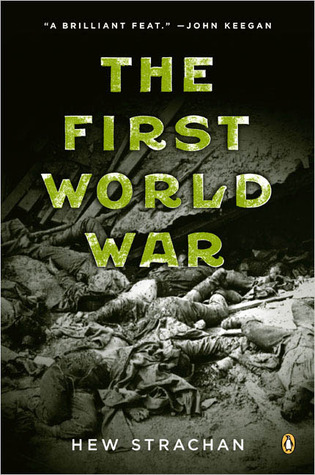The First World
War
Hew Strachan
First American Edition, Viking 2004
ISBN 0-670-03295-6
 This is a totally fascinating book. In only 340 pages, the
author manages to capture the entire world-wide extent of the First World War:
Western Front (with which we are most familiar), Eastern Front, Italian Front,
Middle East, Africa and the Far East; the land battles, the naval battles; and
the politics.
This is a totally fascinating book. In only 340 pages, the
author manages to capture the entire world-wide extent of the First World War:
Western Front (with which we are most familiar), Eastern Front, Italian Front,
Middle East, Africa and the Far East; the land battles, the naval battles; and
the politics.
The author, Hew Strachan (now Sir Hew Strachan), is Chichele Professor of the
History of War at Oxford University; he is particularly well known for his work
on the history of the First World War. It takes a very good academic to boil
all of that detail down to only the salient points, and then a very good writer
to convey only the essentials without making the book unreadable for ordinary
mortals. The style is of necessity almost telegraphic, but it stills reads
very well.
Likewise of necessity, the book tends to be thematic rather than
chronological. Each of its ten chapters discusses a particular aspect of the
war. The chapters are arranged in roughly chronological order, but the content
of each chapter overlaps with the content of other chapters because specific
events can be looked at in different ways.
Readers looking for an overview of the war through Canadian eyes will be
disappointed; Strachan's viewpoint is indeed global. And readers who want to
focus on the battlefield drama will also be disappointed. Specific battles are
mentioned, but only in the context of policy being executed or in terms of their
influence on policy. Vimy Ridge, for example, which is quite rightly big in
Canadian eyes, is mentioned but is not distinguished from other similar
victories.
This book is valuable because it illustrates that the war was indeed a
global war. Canadians tend to focus on the Western Front because the events
in this sector were the making of Canada as a nation. But battles on other
fronts were perhaps even more apocalyptic.
But while focusing on the strategic aspects, developments on the battlefield
are not completely neglected. For example, with respect to the western front,
Strachan notes that, particularly in the early years, command and control
difficulties contributed in large measure to the inability of either side to
exploit tactical successes. And in the latter part of the war the effectiveness
of artillery improved tremendously and was used in far greater concentrations
in attempts to minimize casualties.
And behind all of the battlefield drama was the political drama. The book
shows, for example, that the end of the war was precipitated by Germany's
internal political collapse, in turn aided by, among other things, the allied
naval blockade.
This book was written about ten years ago, but it came to my attention only
this past summer when a ten-part television mini-series, prepared in parallel
with the book, was re-broadcast on TV Ontario. The titles of the ten episodes
in the TV series are the same as those of the ten chapters in the book, and one
can see parallels between the content of each chapter and its corresponding
episode in the TV series, but the exigencies of the video medium require that
the focus/emphasis be quite different. (Apologies to those readers who do not
have access to TV Ontario!)
A remarkable book; Highly recommended, especially for those readers who want
a better idea of how all of the war's aspects fitted together.

|

|
Last updated: 14 September 2014
|
 This is a totally fascinating book. In only 340 pages, the
author manages to capture the entire world-wide extent of the First World War:
Western Front (with which we are most familiar), Eastern Front, Italian Front,
Middle East, Africa and the Far East; the land battles, the naval battles; and
the politics.
This is a totally fascinating book. In only 340 pages, the
author manages to capture the entire world-wide extent of the First World War:
Western Front (with which we are most familiar), Eastern Front, Italian Front,
Middle East, Africa and the Far East; the land battles, the naval battles; and
the politics.